
|
You entered: background
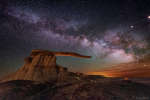 King of Wings Hoodoo under the Milky Way
King of Wings Hoodoo under the Milky Way
28.03.2017
This rock structure is not only surreal -- it's real. The reason it's not more famous is that it is, perhaps, smaller than one might guess: the capstone rock overhangs only a few meters.
 The Race to Reveal Our Universe
The Race to Reveal Our Universe
9.05.2000
A race is underway to understand our universe through background radiation produced during its infancy. Observationally, increasingly accurate balloon experiments are pressing to beat future space-faring satellites to definitive measurements of universe-determining spot characteristics of the cosmic microwave background (CMB) radiation.
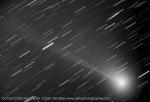 C 2001 A2 (LINEAR): Comet
C 2001 A2 (LINEAR): Comet
5.07.2001
Comet C/2001 A2 (LINEAR) has crossed the celestial equator and is heading north. Outward bound, this primordial piece of the solar system is still just visible to the unaided eye and can now be sighted by northern hemisphere skygazers as it moves through the constellation Pisces.
 Andromeda Station
Andromeda Station
26.03.2020
This surreal picture isn't from a special effects sci-fi movie. It is a digital composite of frames of the real Andromeda Galaxy, also known as M31, rising over a real mountain. Exposures tracking the galaxy and background stars have been digitally combined with separate exposures of the foreground terrain.
 APOD: 2024 July 21 Б King of Wings Hoodoo under the Milky Way
APOD: 2024 July 21 Б King of Wings Hoodoo under the Milky Way
21.07.2024
This rock structure is not only surreal -- it's real. Perhaps the reason it's not more famous is that it is smaller than one might guess: the capstone rock overhangs only a few meters.
 Milky Way over the Pinnacles in Australia
Milky Way over the Pinnacles in Australia
17.02.2016
What strange world is this? Earth. In the foreground of the featured image are the Pinnacles, unusual rock spires in Nambung National Park in Western Australia. Made of ancient sea shells (limestone), how these human-sized picturesque spires formed remains unknown.
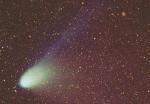 Comet Hale-Bopp and the Dumbbell Nebula
Comet Hale-Bopp and the Dumbbell Nebula
20.02.1997
Comet Hale-Bopp is now slowly moving across the morning sky. During its trip to our inner Solar System, the comet passes in front of several notable objects. Here Comet Hale-Bopp was photographed on February 11th superposed nearly in front of the picturesque Dumbbell Nebula, visible on the upper right.
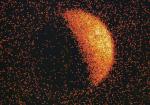 X-Ray Moon
X-Ray Moon
4.10.2003
This x-ray image of the Moon was made by the orbiting ROSAT (Röntgensatellit) Observatory in 1990. In this digital picture, pixel brightness corresponds to x-ray intensity. Consider the image in three parts: the bright hemisphere of the x-ray moon, the darker half of the moon, and the x-ray sky background.
 The Milky Way's Center
The Milky Way's Center
15.03.1997
Although the Earth is round, our Galaxy appears truly flat. This was shown in dramatic fashion by the COsmic Background Explorer (COBE) satellite which produced this premier view of the central region of our own Milky Way Galaxy in infrared light in1990.
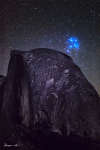 Pleiades over Half Dome
Pleiades over Half Dome
19.07.2022
Stars come in bunches. The most famous bunch of stars on the sky is the Pleiades, a bright cluster that can be easily seen with the unaided eye. The Pleiades lies only about 450 light years away, formed about 100 million years ago, and will likely last about another 250 million years.
|
January February March April |
|||||||||||||||||||||||||||||||||||||||||||||||||